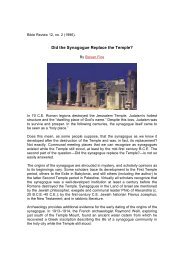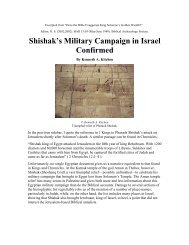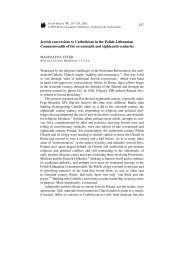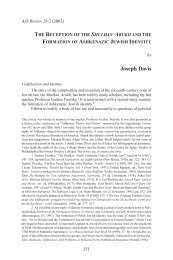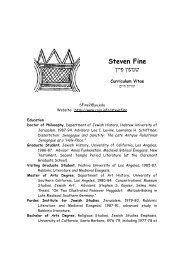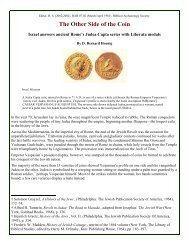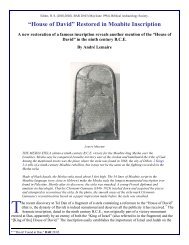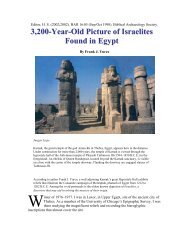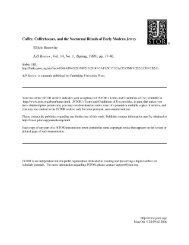jews and christians in fifteenth-century spain
jews and christians in fifteenth-century spain
jews and christians in fifteenth-century spain
You also want an ePaper? Increase the reach of your titles
YUMPU automatically turns print PDFs into web optimized ePapers that Google loves.
8 PAST AND PRESENT NUMBER 174<br />
ridiculed.14 In the early fourteenth <strong>century</strong>, Rabbi Shelomo ben<br />
Abraham ben Adret of Barcelona, the lead<strong>in</strong>g rabb<strong>in</strong>ic authority of<br />
his day, made clear just how little halakhic (legal) weight genealogical<br />
<strong>in</strong>vestigations should have. Respond<strong>in</strong>g to a case <strong>in</strong> which<br />
litigants attempted to bar two brothers from giv<strong>in</strong>g testimony on<br />
the grounds that they had a slave ancestor, Adret responded that<br />
‘all Jewish families must be held as fit <strong>and</strong> emanat<strong>in</strong>g from the<br />
children of Israel’; <strong>and</strong>, he added, ‘if we take seriously the authors<br />
of such libels, there will not rema<strong>in</strong> a s<strong>in</strong>gle family [<strong>in</strong> Israel] that<br />
will be considered fit from the st<strong>and</strong>po<strong>in</strong>t of ancestry’.15<br />
Among the Christian European nobility genealogy had long<br />
played a more important role than it had done amongst the Jews,<br />
one that for a variety of reasons became critical (as well as better<br />
documented) <strong>in</strong> the fourteenth <strong>century</strong>. In Western Europe this<br />
period saw the widespread adoption of armorial bear<strong>in</strong>gs, the<br />
development of heraldry, <strong>and</strong> the dissem<strong>in</strong>ation of the ‘family<br />
tree’ as a st<strong>and</strong>ard way of represent<strong>in</strong>g l<strong>in</strong>eage.16 Also, with<strong>in</strong><br />
each of the pen<strong>in</strong>sular k<strong>in</strong>gdoms specific pressures contributed to<br />
the particular flavour of genealogical concerns. In Aragon, for<br />
example, the grow<strong>in</strong>g pressure of taxation led to an explosion of<br />
procesos de <strong>in</strong>fanzonía <strong>in</strong> the first half of the fourteenth <strong>century</strong>,<br />
by which thous<strong>and</strong>s of people attempted (generally successfully)<br />
to show their descent from tax-exempt m<strong>in</strong>or nobility. In Castile,<br />
on the other h<strong>and</strong>, the civil wars of mid-<strong>century</strong> had resulted <strong>in</strong><br />
a new royal dynasty which drew its gr<strong>and</strong>ees from an (almost)<br />
entirely new circle of families. In that k<strong>in</strong>gdom, it was the high<br />
nobility who displayed the greatest genealogical creativity as it<br />
attempted to establish its bona fides.17<br />
14 As a descendant of the Kalonymide dynasty wrote c.1320 <strong>in</strong> Catalonia, about a<br />
man who boasted of his l<strong>in</strong>eage, ‘yet perhaps his family was the youngest from among<br />
those of whom it is written: “they ravished the women <strong>in</strong> Zion” on the bitter day,<br />
<strong>in</strong> the time of oppression’: R. Kalonymos, Even Boh1an (Lemberg, 1865), 24 ff., 35<br />
ff., cited <strong>in</strong> Yitzhak Baer, A History of the Jews <strong>in</strong> Christian Spa<strong>in</strong>, 2 vols. (Philadelphia,<br />
1961), ii, 19. The quotation is from Lam. 5:11; Kiddush<strong>in</strong> 71b.<br />
15 B. Netanyahu, ‘The Racial Attack on the Conversos: Américo Castro’s View of<br />
its Orig<strong>in</strong>’, <strong>in</strong> Netanyahu, Toward the Inquisition, 34, cit<strong>in</strong>g RaShbA, responsum,<br />
no. 386. RaShbA may have been allud<strong>in</strong>g to Maimonides, who went further, suggest<strong>in</strong>g<br />
ironically that anyone given to mak<strong>in</strong>g such accusations was himself suspect<br />
of mixed ancestry, because a true Jew would not make such a charge: see Mishneh<br />
Torah, Sefer Qedushah, ch. 19 (V.17).<br />
16 The literature on all these topics is vast. For a recent <strong>and</strong> particularly illum<strong>in</strong>at<strong>in</strong>g<br />
example, see Christiane Klapisch-Zuber, L’Ombre des ancêtres (Paris, 2000).<br />
17 For Castile the classic work is Salvador de Moxó, ‘De la nobleza vieja a la nobleza<br />
nueva: la transformación nobiliaria castellana en la baja edad media’, Cuadernos de<br />
historia, iii (1969). See also Adel<strong>in</strong>e Rucquoi, ‘Être noble en Espagne aux XIVe–XVIe<br />
(cont. on p. 9)



